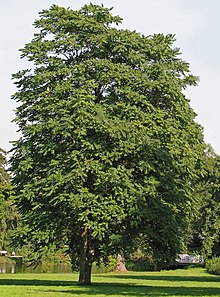Tree of Heaven
| Tree of Heaven | |
|---|---|
 |
|
| Large specimen growing in a park in Germany | |
| Scientific classification | |
| Kingdom: | Plantae |
| Clade: | Angiosperms |
| Clade: | Eudicots |
| Clade: | Rosids |
| Order: | Sapindales |
| Family: | Simaroubaceae |
| Genus: | Ailanthus |
| Species: | A. altissima |
| Binomial name | |
|
Ailanthus altissima (Mill.) Swingle |
|
| Synonyms | |
|
|
Ailanthus altissima /eɪˈlænθəs ælˈtɪsᵻmə/, commonly known as tree of heaven, ailanthus, or in Standard Chinese as chouchun (Chinese: ; pinyin: chòuchūn; literally: "foul smelling tree"), is a deciduous tree in the Simaroubaceae family. It is native to both northeast and central China, as well as Taiwan. Unlike other members of the genus Ailanthus, it is found in temperate climates rather than the tropics. The tree grows rapidly and is capable of reaching heights of 15 metres (49 ft) in 25 years. However, the species is also short lived and rarely lives more than 50 years, though its remarkable suckering ability makes it possible for this tree to clone itself indefinitely and live considerably longer (since they are linked to the mother tree and thus partly fed by it, the suckers are less vulnerable than the seedlings and can grow faster).
In China, the tree of heaven has a long and rich history. It was mentioned in the oldest extant Chinese dictionary and listed in countless Chinese medical texts for its purported ability to cure ailments ranging from mental illness to baldness. The roots, leaves and bark are still used today in traditional Chinese medicine, primarily as an astringent. The tree has been grown extensively both in China and abroad as a host plant for the ailanthus silkmoth, a moth involved in silk production. Ailanthus has become a part of western culture as well, with the tree serving as the central metaphor and subject matter of the best-selling American novel A Tree Grows in Brooklyn by Betty Smith.
...
Wikipedia
